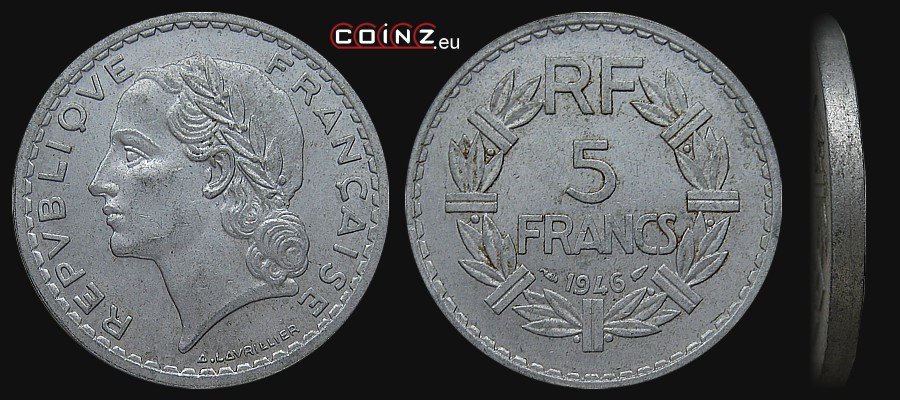5 francs FRANCE (1945-1952)


| diameter: | weight: | thickness: | alloy: |
| 31.5 mm | 3.5 g | 2.35 mm | Al |
obverse:
in the coin centre personification of France - Marianne's head in a laurel wreath facing left; along the left edge: REPVBLIQVE, along the right one: FRANÇAISE (REPUBLIQUE FRANÇAISE - French Republic); ring of trapezoids at the edge
reverse:
in the coin centre in two lines face value: 5 / FRANCS; below year of issue; above the face value: RF (REPUBLIQUE FRANÇAISE - French Republic); a laurel wreath along the edge; ring of trapezoids at the edge
edge:
plain
issue date:
2 II 1945
withdrawal date:
30 VIII 1966
designer:
André-Henri Lavrillier (signature A.LAVRILLIER below Marianne's neck along the obverse bottom)
mint:
 La Monnaie de Paris (The Paris Mint) (mint mark before year of issue in the reverse, after year of issue privy mark of mint's director Lucien Bazor - wing)
La Monnaie de Paris (The Paris Mint) (mint mark before year of issue in the reverse, after year of issue privy mark of mint's director Lucien Bazor - wing)
plant Paris (no letter on the reverse bottom),
plant Beaumont-le-Roger (letter B on the reverse bottom),
plant Castelsarrasin (letter C on the reverse bottom)

mintage:
| Paris | Beaumont-le-Roger | Castelsarrasin | |
| 1945 | 95 398 800 | 6 043 200 | 2 208 114 |
| 1946 | 61 332 000 | 13 360 400 | 1 268 907 |
| 1947 | 46 575 600 | 30 838 800 | - |
| 1948 | 104 473 600 | 28 046 800 | - |
| 1949 | 203 251 600 | 8 414 000 | - |
| 1950 | 128 371 600 | 28 952 000 | - |
| 1952 | 4 000 000 | - | - |
varieties:
1945, 1946 - no letter (plant Paris), or letter B (plant Beaumont-le-Roger), or letter C (plant Castelsarrasin);
1947, 1948, 1949, 1950 - no letter (plant Paris) or letter B (plant Beaumont-le-Roger);

1945, 1947, 1947B, 1948, 1948B, 1949 - closed digits '9' in year of issue or opened digits '9'
1947, 1948, 1949, 1950 - no letter (plant Paris) or letter B (plant Beaumont-le-Roger);

1945, 1947, 1947B, 1948, 1948B, 1949 - closed digits '9' in year of issue or opened digits '9'
mint marks:
interesting facts:
last update: 20 XI 2013
coins catalogue :: katalog monet :: münzkatalog :: catalogue de monnaies :: catálogo de monedas :: catalogo monete :: каталог монет :: κέρματα κατάλογος :: COINZ.eu
© 2010-2025 :: Adam Kubicki :: COINZ.eu :: All rights reserved.


